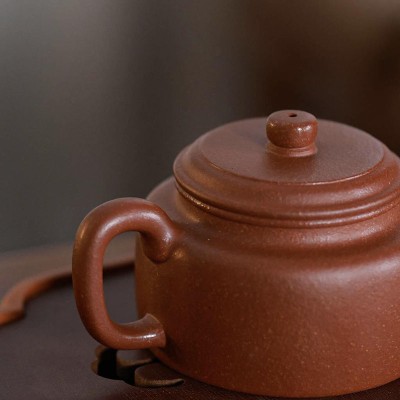









"De" means morality,"zhong" means "bell",The bell-shaped lid and body of this zisha teapot symbolize a person with noble character, frugality, and simplicity. Owning this teapot is seen as a sign of being a true gentleman, as it represents the values of humility and refinement.
 Delivery
Delivery
Free shipping within 1 to 3 days. ETA:5-7 days
 Returns
Returns
Within 28 days after delivery date.
 Security
Security
SSL | GDRP used to ensure information security.
Guarantee safe & secure checkout
Data sheet
My Yixing teapot has turned tea brewing into a symphony of aromas. The clay material seems to coax out the most delightful scents from the tea leaves, creating a sensory experience that is truly enchanting. It's a must-have for any tea lover seeking a multi-sensory journey.
My Yixing teapot is not just a teapot; it's a timeless treasure. The way it enhances the flavor of the tea is truly remarkable. It has added a new layer of richness to my tea-drinking experience and has become the centerpiece of my tea rituals.
A flattened persimmon-shaped teapot is called a "Short Pan," a slightly taller and flattened spherical-shaped teapot is called a "Medium Pan," and a teapot with a taller and pear-shaped body is called a "Tall Pan." When their daughters got married, they would give a Pan teapot as part of their dowry, hoping that their daughters would be able to live a prosperous life like "Pan Shicheng" who the inventor of the "pan" teapot. teapots that are passed down as part of the dowry are not necessarily used for brewing tea, but can also be placed on dressing tables to hold hair oil. After the female owner passes away, they are often used as burial objects to show gratitude to her family for raising her.
Pear-shaped yixing teapot,it is one of the pot styles that originated in the Chian Yuan Dynasty and became popular during the China Ming Dynasty. It is named after its pear-like shape.
"Fanggu" Yixing Teapot - This zisha teapot has an antique cylindrical body shaped like a drum, with a short neck imitating the shape of a drum pot. The spout is also designed to imitate the shape of a drum pot spout, with a straight line. Its advantages include excellent heat preservation, natural color, comfortable texture, and long service life. The "Fanggu" teapot is a unique and elegant choice for tea lovers and collectors alike.
The Melon-shaped Yixing teapot is a classic example of the zisha teapot. It is characterized by its unique shape, which resembles some melon , and is made of purple clay, also known as zisha clay.
"Hehuan" means "all happy",the zisha art master- "Mansheng" was inspired by the beautiful and harmonious sound of the cymbals coming together during the celebration. He believed that this sound brought joy and happiness to people, so he used the shape of the cymbals as a model to design the Hehuan teapot. He named it after the joyous sound they made when struck together, and the teapot's unique shape and design symbolize the harmony and beauty of life.
"Xubian" yixing teapot is considered one of the most challenging shapes to create in traditional handmade purple clay pottery. In fact, it's said in the industry that "one point of shaping equals one point of difficulty in forming." To create this teapot, the potter must start with a cylindrical shape and then use a "clay pat" to gently tap and flatten the clay without causing it to collapse. This requires a great deal of skill and precision in manual operation, making it a difficult and time-consuming process. Despite the challenges, the Xubian teapot is highly valued by collectors and tea enthusiasts for its unique and elegant shape, as well as its ability to brew tea with a rich and full flavor.
The Xishi yixing teapot is the quintessential model and the most popular style of Yixing clay teapot. It boasts a round and plump body, a cut lid, a short spout, and an inverted handle. The pot's body resembles the full breast of a young woman, while the knob on the lid is shaped like a nipple. The bottom of the pot curves inward naturally, and the handle is fashioned like an upside-down ear, reminiscent of the hairstyle of ancient Chinese women. When pouring tea, the handle resembles the slender waist of a beautiful woman. The Xishi teapot is renowned for its unique ability to brew tea, allowing the tea leaves to fully expand and release a more intense aroma and flavor.
"Fanggu" Yixing Teapot - This zisha teapot has an antique cylindrical body shaped like a drum, with a short neck imitating the shape of a drum pot. The spout is also designed to imitate the shape of a drum pot spout, with a straight line. Its advantages include excellent heat preservation, natural color, comfortable texture, and long service life. The "Fanggu" teapot is a unique and elegant choice for tea lovers and collectors alike.
"Shuiping“ zisha teapot-Chinese Kung Fu tea is a traditional brewing method that involves putting a large amount of tea leaves in a teapot and only brewing with boiling water, allowing the tea juice to slowly seep out. To achieve this, the teapot must be placed in a tea bowl or tea sea, with hot water poured around the outside of the teapot, causing it to float in the hot water and allowing the tea juice to be brewed. This requires an exquisite production process, with the clay used for the spout and handle of the teapot being of equal quality. When the teapot floats on the surface of the water, it must maintain a horizontal position without tilting, hence the name "shuiping" teapot.
"Duozhi" yixing teapot is a unique and distinctive shape in the world of Yixing zisha teapots. Its shape resembles a pile of spheres and hemispheres stacked together, giving it a unique and eye-catching appearance. The name "Duo Zhi" comes from the Chinese word for "stacking and linking." Due to its unique appearance, this type of teapot is commonly referred to as the "Duozhi teapot." Interestingly, the name "Duozhi" in Chinese also carries a positive connotation, meaning "many children, much happiness." This adds to the charm and appeal of this teapot, making it a popular choice for collectors and tea enthusiasts alike.
"Shipiao" Yixing teapot- this zisha teapot is a traditional Chinese tea set characterized by its gourd-like or calabash-like shape, with a small top and large bottom, a sturdy and short spout, and a pyramid-shaped body that exudes elegance. Made from high-quality purple clay material, this teapot is known for its hardness and durability, as well as its stable and easy-to-use design. The short and powerful straight spout ensures a smooth and steady flow of water, while the pyramid-shaped body adds a touch of sophistication to any tea ceremony.
The design of the Palace Lamp "Gongdeng" in the Yongzheng period of the Qing Dynasty. Its prototype was a lantern, designed by an old man from Tuntou Village. Later, the Tuntou Lantern was presented as a tribute to a county-level official who took it to the palace. The Tuntou Lantern was named "Gongdeng" and became an exclusive item for the imperial palace. Later, people replaced the character "Gong" with "Palace," and it became the "Palace Lamp" we know today. The Palace Lamp teapot is designed based on this lantern, often appearing in a square shape with a fresh, natural, and elegant style that is in line with the aesthetic views of ancient people and easily accepted by modern people.
"Shipiao" Yixing teapot- this zisha teapot is a traditional Chinese tea set characterized by its gourd-like or calabash-like shape, with a small top and large bottom, a sturdy and short spout, and a pyramid-shaped body that exudes elegance. Made from high-quality purple clay material, this teapot is known for its hardness and durability, as well as its stable and easy-to-use design. The short and powerful straight spout ensures a smooth and steady flow of water, while the pyramid-shaped body adds a touch of sophistication to any tea ceremony.
"De" means morality,"zhong" means "bell",The bell-shaped lid and body of this zisha teapot symbolize a person with noble character, frugality, and simplicity. Owning this teapot is seen as a sign of being a true gentleman, as it represents the values of humility and refinement.
"Rongtian" yixing teapot takes its inspiration from the "big-bellied" Arhat in Buddhism, named after the saying "a big belly can hold the world's affairs". It is difficult to fully capture the charm of this teapot, as it requires the maker to truly understand its essence. A slightly shorter neck is added to the full-bodied teapot, while the lid is raised to a half-spherical shape, giving it a simple and childlike charm. The teapot has excellent pouring performance and is comfortable to use. Visually, it exudes a dignified and generous aura while embodying depth within simplicity.
This is a type of teapot shape that was created during the Yuan Dynasty. It's called "SengMao" because the shape of the spout resembles a monk's hat. The shape of the teapot has a raised lip, a low front and high back, a duck-bill shaped spout, and the lid rests inside the lip. It has a narrow neck, a bulging belly, a circular foot, and a curved handle, and is characterized by a strong ethnic minority style.. Initially, it was used exclusively for Buddhist monks to drink tea, but over time it gradually became a classic shape of the square zisha teapot.
NOTICE : Cookies ensure the smooth running of our services and improve user experience,Using these, you accept the use of cookies. Learn More.